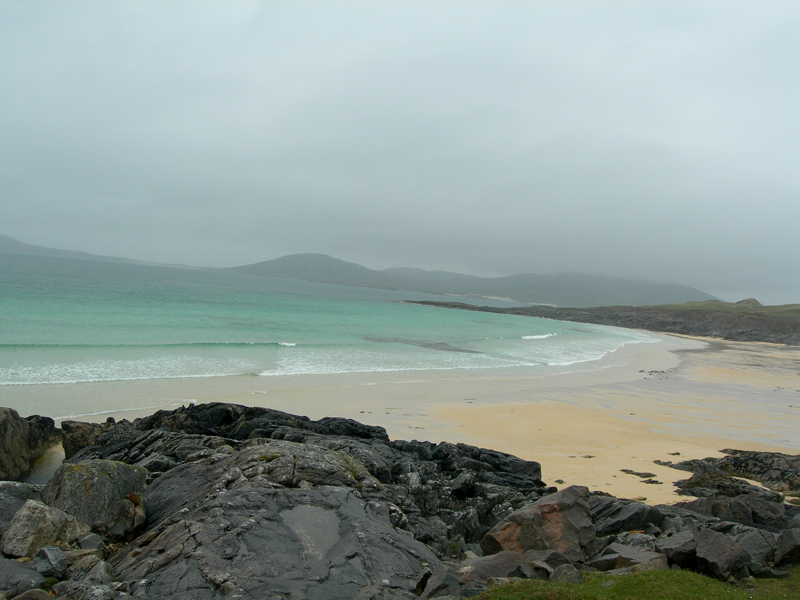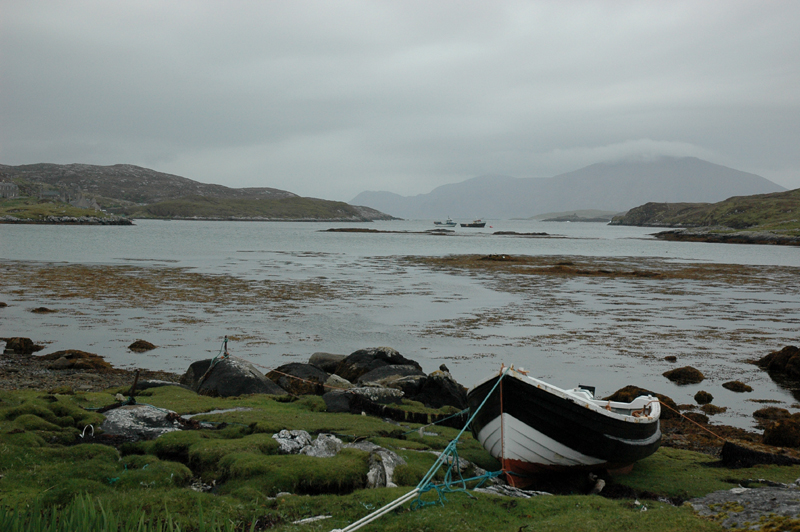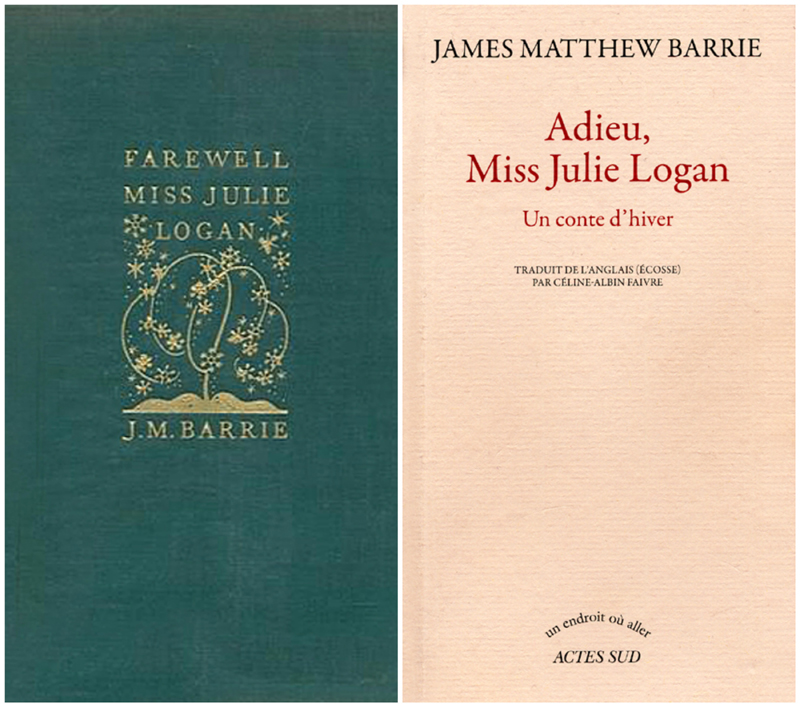Dear readers,
We have wonderful memories of our trips in the Outer Hebrides in 2003, 2004 and 2006 which led us from Lewis in the north to Barra and Vatersay in the south. We’re eager to go back there to immerse in the wild and colourful ‘lunar’ landscapes we’ve passed through, to get in closer touch with the elements on wintry shores.
We miss the solitary mountains, the rocky landscapes interspersed with patches of colours, the shining lochs reflecting the barren slopes sometimes covered with purple heather, the turquoise-blue waters of the pink sandy beaches, the green salt marshes where sheeps are grazing, the thick and flowery green carpet known locally as the ‘machair’, the peat fields, the wild flowers and the birds… in a word we miss the whole place !
On the above map the A 859 clearly appears as the main road from Tarbert to Rodel where there is a most interesting old chapel to visit, but there is another road, hardly visible on the map, which winds and twists its way along the south east coast of Harris. This single track road is known as the ‘Golden Road’ and if the weather is nice it is worth to take it to discover the other side of the island.
Now, you may ask, what is the link with J.M. Barrie, the very well-know Scottish author of Peter Pan ?
J.M. Barrie portrait – The Plays of J.M. Barrie – Hodder and Stoughton 1936
After the death of his friends Arthur and Sylvia Llewelyn Davies, in 1907 and 1910, J. M. Barrie, called “Uncle Jim”, decided to adopt their five boys, George, John (Jack), Peter, Michael and Nicholas (Nico). He had first met George and Jack together with their nurse and baby Peter in London’s Kensington Gardens where he used to walk his Saint Bernard dog Porthos. He lived in a house nearby. In July 1912, J.M. Barrie decided to take the boys with him on fishing holidays in a very remote place in the Outer Hebrides.
After staying some time at the Harris Hotel, in Tarbert, where J.M. Barrie engraved his initials on the glass pane of a dining room window, the whole team went further south up to Ammhuinsuidh Castle.
It is in Ammhuinsuidh Castle that the author of Peter Pan conceived his famous play, Mary Rose, a story which takes place in a little island called ‘Mary Rose’ situated in the nearby Loch Voshimid. We’ll try to locate the loch and island on our next trip there. The story is based on an old local superstition.
“You don’t have to believe in ghosts .. .. there’s no need to .. .. they will still exist, or not ”
(from Supernatural Scotland by Roddy Martine)
A few days ago I received Celine-Albin Faivre’s remarkable translation of Mary Rose, a famous play by J. M. Barrie which Alfred Hitchcock longed so much to produce, without being able to do so. Mary Rose is a ghost story, part of which takes place in the Outer Hebrides.
Mary Rose is a play by J.M. Barrie, who is best known for Peter Pan. It first played in London in April 1920, with incidental music specially composed by Norman O’Neill. It tells the fictional story of a girl who vanishes twice. As a child, Mary Rose’s father takes her to a remote Scottish island. While she is briefly out of her father’s sight, Mary Rose vanishes. The entire island is searched exhaustively. Twenty-one days later, Mary Rose reappears as mysteriously as she disappeared … but she shows no effects of having been gone for three weeks, and she has no knowledge of any gap or missing time.Years later, as a young wife and mother, the adult Mary Rose persuades her husband to take her to the same island. Again she vanishes: this time for a period of decades. When she is found again, she is not a single day older and has no awareness of the passage of time. In the interim, her son has grown to adulthood and is now physically older than his mother. Barrie, who normally wrote with his right hand, wrote Mary Rose with his left hand due to a “writer’s cramp”. Alfred Hitchcock saw the play in its original production, and wanted to film it, even asking Jay Presson Allen to write a screenplay after she wrote the screenplay for Hitchcock’s Marnie (1964). However, Hitchcock was under contract to Universal Pictures which felt the project was not commercial enough.
http://en.wikipedia.org/wiki/Mary_Rose_%28play%29
Compare the beautiful cover of the French edition by Terre de Brume, with the austere blue covers used for the first Hodder & Stoughton’s common English editions of JM Barrie’s books, published in the 1920’s.
And now, here a few of our photos to feel the atmosphere of the place which has inspired the author of Mary Rose.
Below is the extract of Act I of Mary Rose which best describes the setting and circumstances of the story.
ACT I
MR. MORLAND. It can’t be told quite in a word. It happened seven years ago, when Mary Rose was eleven. We were in a remote part of Scotland – in the Outer Hebrides.
SIMON. I once went on shore there from the Gadfly, very bleak and barren, rocks and rough grass, I never saw a tree.
MR. MORLAND. It is mostly like that. There is a whaling-station. We went because I was fond of fishing. I haven’t had the heart to fish since. Quite close to the inn where we put up there is – a little island.
(He sees that little island so clearly that he forgets to go on.)
MRS. MORLAND. It is quite a small island, Simon, uninhabited, no sheep even. I suppose there are only about six acres of it. There are trees there, quite a number of them, Scotch firs and a few rowan-trees, – they have red berries, you know. There seemed to us to be nothin very particular about the island, unless, perhaps, that it is curiously complete in itself. There is a tiny pool in it that that might be called a lake, out of which a stream flows. It has hillocks and a glade, a sort of miniature land. That was all we noticed, though it became the most dreaded place in the world to us.
MR. MORLAND. (considerately). I can tell him without your being here
MRS. MORLAND. I prefer to stay, James.
MR. MORLAND. I fished a great deal in the loch between that island and the larger one. The sea-trout were wonderful. I often rowed Mary Rose across to the island and left her there to sketch. She was fond of sketching in those days, we thought them pretty things. I could see her from the boat most of the time, and we used to wave to each other. Then I would go back for her when I stopped fishing.
MRS. MORLAND. I didn’t often go with them. We didn’t know at the time that the natives had a superstition against landing on the island, and that it was supposed to resent this. It had a Gaelic name which means ‘ The Island that Likes to be Visited.’ Mary Rose knew nothing of this, and she was very fond of her island. She used to talk to it, call it her darling, things like that.
SIMON (restless). Tell me what happened.
MR. MORLAND. It was on what was to be our last day. I had landed her on this island as usual, and in the early evening I pulled across to take her off. From the boat I saw her, sitting on a stump of a tree that was her favourite seat, and she waved gaily to me and I to her. Then I rowed over, with, of course, my back to her. I had less than a hundred yards to go, but, Simon, when I got across she wasn’t there.
SIMON. You seem so serious about it. She was hiding from you ?
MRS. MORLAND. She wasn’t on the island, Simon.
SIMON. But – but – oh, but —
MR. MORLAND. Don’t you think I searched and searched ?
MRS. MORLAND. All of us. No one in the village went to bed that night. It was then we learned how they feared the island.
MR. MORLAND. The little pool was dragged. There was nothing we didn’t try; but she was gone.
SIMON. (distressed). I can’t – there couldn’t – but never mind that. Tell me how you found her.
MRS. MORLAND. It was the twentieth day after she disappeared. Twenty days !
SIMON. Some boat —— ?
MR. MORLAND. There was not boat but mine.
SIMON. Tell me.
MRS. MORLAND. The search had long been given up, but we couldn’t come away.
MR. MORLAND. I was wandering one day along the shore of the loch, you can imagine in what state of mind. I stopped and stood looking across the water at the island, and, Simon, I saw her sitting on the tree-trunk sketching.
MRS. MORLAND. Mary Rose !
MR MORLAND. She waved to me and went on sketching. I — I waved back to her. I got into the boat and rowed across just in the old way, except that I sat facing her, so that I could see her all the time. When I landed, the first thing she said to me was, ‘Why did you row in that funny way, Dad ?’ The I saw at once that she didn’t know anything had happened.
http://youtu.be/EKcfKFo_l9k
I hope to have made you feel like reading this thrilling ghost story written by one of the greatest Scottish authors and also visiting this wonderful place in the Outer Hebrides.
By the way, for those who love ghost stories, J.M. Barrie also wrote Adieu Miss Julie Logan, a story taking place in Glen Prose, a glen situated not far from Kirriemuir.
A bientôt.
Mairiuna













Many thanks for your words about my translation.
I visited Lewis/Harris island a few years ago too.
http://sirjmbarrie.com/bibliographie/pelerinage/voyage4.htm
All the best,
C.-A. F.
Bonjour Céline
Un grand grand MERCI pour votre commentaire sur Scotiana qui nous a fait bien plaisir et à plus d’un titre. Je suis moi-même une fan de ” Roses de Décembre” et de toute l’oeuvre de sa géniale créatrice et cela depuis plusieurs années même si je n’ai jamais réussi à faire valider mon adresse e-mail pour m’abonner (“That email doesn’t look right. Please try again”).
Je crois que je possède tous les livres de JM Barrie que vous avez traduits en français, et remarquablement bien traduits soit dit en passant, ce qui n’était pas si simple. J’aime particulièrement vos introductions qui apportent beaucoup d’eau au moulin comme on dit en France. Bravo aussi pour le choix des couvertures qui sont fort belles, qu’il s’agisse de celle de Mary Rose de Léo Bates ou de celles du Petit Oiseau blanc qui mettent en valeur Arthur Rackam, le génial illustrateur de JMB. Je possède les deux éditions du Petit Oiseau blanc, la plus ancienne étant couverte d’annotations ;-). J’ai toujours trouvé que les couvertures des éditions originales de JMB étaient trop austères et ne portaient pas au rêve, ce qui est quand même un comble quand il s’agit d’un auteur tel que JMB.
Je dois vous avouer que je suis contente d’avoir pu lire en français quelques uns des livres de ce grand auteur écossais. Puissiez-vous les traduire tous ! Je les lis en anglais mais cela fait quand même du bien de retrouver sa langue natale parfois. Il y a forcément des choses qui échappent au lecteur français à la lecture d’un auteur en langue originale. Un grand MERCI donc pour ces traductions. De ce mystérieux “Au-Delà” d’où émanent souvent d’étranges complicités, l’auteur doit en être lui-aussi très heureux. Janice, notre amie québécoise, co-auteur et webmaster de notre blog qui partage aussi nos voyages depuis quelque années, et moi-même nous aimons beaucoup la lecture. C’est bien-sûr JM Barrie qui m’a amenée à découvrir votre site. Nous avons visité avec beaucoup d’émotion sa maison natale à Kirriemuir avant d’aller nous recueillir sur sa tombe, non loin de là. Nous avons par ailleurs fait d’autres parcours littéraires en Écosse et d’autres sont à venir car nous envisageons de repartir en Écosse une huitième fois en mai-juin. J
Le récit et les petits films de votre voyage au pays des soeurs Brontê m’a également beaucoup enthousiasmée et donné envie d’aller faire un petit détour dans le Nord de l’Angleterre.
Qui mieux que vous aurait pu traduire JMB :
“Dilettante. Pirate à seize heures, bien que n’ayant pas le pied marin. En devenir de qui j’ose être. Docteur en philosophie de la Sorbonne. Amie de James Matthew Barrie et de Cary Grant. Traducteur littéraire. Parfois dramaturge et biographe. Créature qui écrit sans cesse. Je suis ce que j’écris. Je ne serai jamais moins que ce que mes rêves osent dire.”
Bon courage pour la suite de vos travaux.
En toute complicité et avec toute notre amitié.
Mairiuna et toute l’équipe de Scotiana